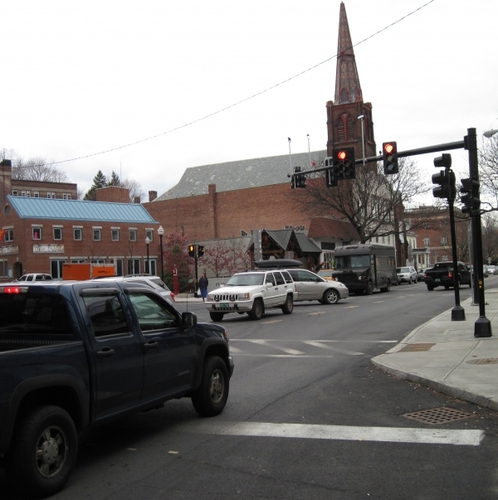BRATTLEBORO — Most drivers and pedestrians navigating downtown know that the place has its quirks.
Last year, when damage to the downtown traffic system precipitated weeks of the traffic signals set to flash, some visitors celebrated. Others cursed. Many of them called the Selectboard with comments.
As timing would have it, the Department of Public Works had commissioned Milone & MacBroom of Springfield, Mass., to conduct a traffic study of downtown, the first full-on assessment since 2009, when the state rehabbed Route 5.
Traffic Engineer Van Kacoyannakis with Milone & MacBroom told the Selectboard on March 8 that the town could make slight tweaks to the traffic signals' timing.
But overall, he said, the system operates as well as it can given the number of streets (especially “malfunction junction”), the number of pedestrians, and the volume of traffic in the commercial area.
Kacoyannakis recommended in his report:
• Improve signal timing to handle current traffic flows.
• Install central software that makes instant timing changes and collects data.
• Use “adaptive traffic controllers” that change signal timing based on real-time demand.
Director of Public Works Steve Barrett wrote in a March 3 memo to the board, “Unfortunately, due to the physical limitations of the roadways, these changes will only make small improvements.”
Both Barrett and Kacoyannakis agree that while some of the intersections' timing could be improved, the downtown mostly operates as safely and as efficiently as possible.
The five-legged intersection of Bridge Street (Route 119)/Main and Canal streets (Route 5)/Vernon Street (Route 142)/Brattleboro Food Co-op parking lot, commonly called “Malfunction Junction,” was the system's outlier. Further complicating the traffic flow is a railroad crossing on Bridge Street.
Kacoyannakis told the board that making huge changes to upper Main Street and the side streets of Flat, Elliot, and High would gum up Malfunction Junction - and vice-versa.
For the assessment, Kacoyannakis investigated keeping the traffic system on flashing lights. Drivers on Main Street would have the right of way through flashing yellow lights, while drivers on the side streets, like High or Elliot, would encounter a red flashing light. Pedestrians would cross when they could.
“There's a false sense of safety with flashing lights,” he said, but the reality is different.
“A driver typically uses every gap [in the traffic] possible,” Kacoyannakis said. “Most drivers when they have a flashing yellow, they don't slow down.”
When Selectboard Chair David Gartenstein asked if Kacoyannakis would recommend keeping the traffic signals on flash, Kacoyannakis answered, “No, I would not recommend that.”
He also looked at converting Flat Street into a one-way, but that change wouldn't alleviate congestion and could negatively affect businesses, he said.
Kacoyannakis also tested traffic flows by changing the timing of pedestrian crossings. Brattleboro's current system uses “exclusive pedestrian crossing.” When the bird chirps at an intersection and gives pedestrian the go-ahead to cross, it chirps for the entire intersection.
“There is, extremely, a lot of pedestrians crossing at each of of these intersections,” he said.
As an example, during the peak weekday afternoon hour, more than 100 people crossed Elliot Street.
Kacoyannakis investigated how traffic would operate if Brattleboro moved to a “concurrent pedestrian crossing.” Under this configuration, traffic would flow through one part of the intersection, like Main Street, while pedestrians cross at the side street, like Elliot.
Again, he suggested keeping the current configuration.
Kacoyannakis believes that pedestrian safety and meeting requirements of the federal Americans with Disabilities Act would diminish with a concurrent pedestrian-crossing system.
Pushing a button
Barrett told the board that his department wants to change the pedestrian buttons on the crossing signals.
The department staff has contacted different vendors to build “a better quality pedestrian button system.”
“The current ones malfunction, regularly disrupting traffic flow,” said Barrett. “We recommend replacing all of the pedestrian buttons for an estimated cost of $11,200.”
